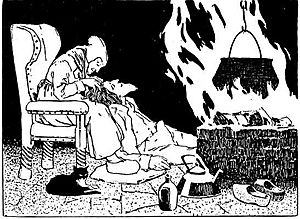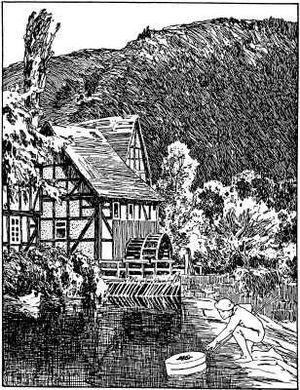The Devil with the Three Golden Hairs facts for kids
Quick facts for kids The Devil with the Three Golden Hairs |
|
|---|---|

The grandmother plucks the hairs from the devil's head. Illustration by Otto Ubbelohde.
|
|
| Folk tale | |
| Name | The Devil with the Three Golden Hairs |
| Data | |
| Aarne–Thompson grouping |
|
| Region | Germany |
| Published in | Kinder- und Hausmärchen, by the Brothers Grimm |
| Related | The King Who Would Be Stronger Than Fate |
"The Devil with the Three Golden Hairs" is a classic German fairy tale. It was collected by the famous Brothers Grimm. This story is about a poor boy who is destined to marry a princess. It also tells how he gets three special golden hairs from a powerful, giant-like figure. The tale is known in German as Der Teufel mit den drei goldenen Haaren.
Contents
The Boy and the King's Plan
The story begins with a poor woman. She gave birth to a son who was born with a special sign. People believed this sign meant he would marry the king's daughter. This would happen when he turned fourteen years old.
The king heard about this prophecy. He was a wicked man and did not want his daughter to marry a poor boy. So, he visited the family. He pretended to be kind and offered to raise the boy in his castle. But his real plan was to get rid of the child. The king put the baby in a box. Then he threw the box into the river. He hoped the boy would drown.
However, the box did not sink. It floated down the river to a mill. The miller and his wife found the box. They were surprised to find a baby inside. They decided to raise the boy as their own son.
A Surprise Return
Fourteen years passed quickly. The boy grew into a strong young man. One day, the king visited the mill by accident. He did not know it was the same boy. The king asked the miller about the young man. The miller explained how he and his wife found him. He told the king about the box in the river.
The king was shocked to see the boy alive. He realized his plan had failed. But he still wanted to stop the marriage. He gave the young man a sealed letter. The king told him to deliver it to the queen. Inside the letter, the king had written a terrible command. It ordered the queen to kill the boy as soon as he arrived.
A Change of Plans
On his way to the castle, the boy needed a place to sleep. He found an old woman's house and asked for shelter. The old woman warned him that robbers often visited her house. But the boy was very tired. He said he could not walk any further and fell asleep.
Later that night, the robbers arrived. They found the sleeping boy and the king's letter. They read the letter and felt sorry for him. They decided to help the boy. Without waking him, they swapped the letter. The new letter told the queen to marry the boy to the king's daughter.
The next morning, the robbers showed him the way to the castle. The boy continued his journey. When he arrived, the queen read the new letter. She followed the instructions. The wedding happened, and the boy married the princess.
The Devil's Golden Hairs
When the king returned, he was furious. His plan had failed again. He decided on one last, impossible task. He ordered the young man to travel to Hell. He had to bring back three golden hairs from the Devil himself. The king hoped this would finally get rid of his new son-in-law.
On his journey, the boy faced three challenges. He passed through two towns and crossed a river. In each place, people asked him about his skills. He always replied, "I know everything."
- In the first town, people asked why their well was dry. It used to flow with wine but now had no water.
- In the second town, they asked why a special tree no longer grew golden apples. It did not even have leaves.
- When crossing the river, the ferryman asked why he had to row forever. He wanted to be free.
To each question, the boy gave the same answer. He said, "You will know that when I come back."
Meeting the Devil's Grandmother
The boy found the entrance to Hell. Inside, he met only the Devil's grandmother. He told her his mission. She promised to help him. She turned him into an ant. Then she hid him in the folds of her clothes.
Soon, the Devil returned home. He smelled human flesh. "I smell a human!" he roared. But his grandmother calmed him down. She convinced him to eat and drink. After his meal, the Devil rested his head in her lap. He soon fell into a deep, drunken sleep.
The grandmother then plucked a golden hair from his head. She did this three times. Each time, the Devil woke up. He thought the pain was part of his dreams. He told his grandmother about his visions:
- The dry well had a toad underneath it. The toad was blocking the water flow.
- The apple tree had a mouse gnawing at its root. This stopped it from growing fruit or leaves.
- The ferryman could be freed. He just needed to hand his oar to another person on the riverbank.
Returning Home with Answers
The next morning, the Devil left his home. The grandmother changed the boy back to his normal self. He thanked her for her help. He took the three golden hairs and started his journey home.
On his way back, he stopped at the river and the two towns. He shared the answers he had heard from the Devil. Each town was grateful. They gave him two donkeys loaded with gold. He brought this wealth back to the castle.
The king was pleased to see the boy return. He was even happier about the gold. He allowed the boy and his wife to live in peace. The king then asked where the boy found all the gold. He hoped to get some for himself. The boy told him the gold was found across the river.
The King's Fate
The story ends with the king crossing the river. The ferryman took him to the other side. As they reached the bank, the ferryman handed the oar to the king. This act condemned the king. He was now stuck. He would have to ferry travelers back and forth forever.
Influence on Other Stories
This fairy tale might have inspired other famous stories. For example, J. R. R. Tolkien's The Tale of Beren and Lúthien has some similar ideas. In Tolkien's story, an elf-king gives a difficult task to a suitor. He must get one of three special jewels from a powerful enemy. While there are some similarities, the stories are also very different in many ways.


